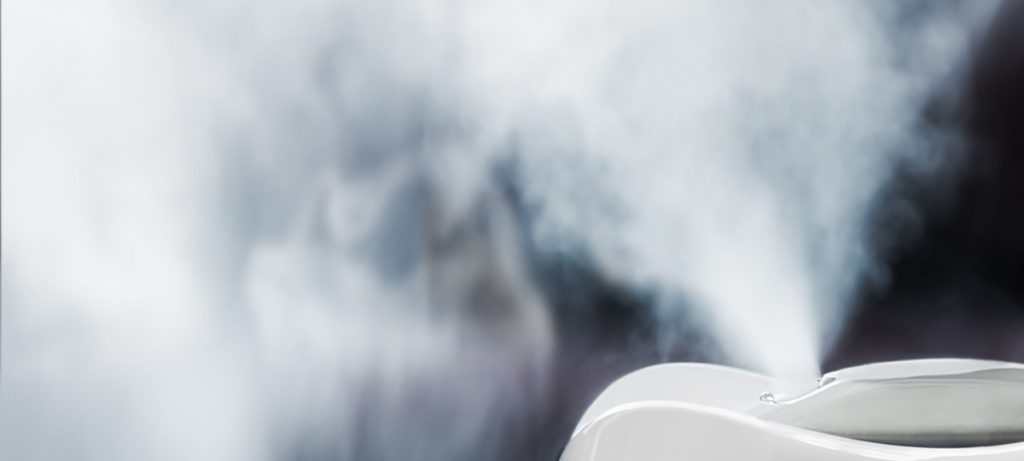Maintaining correct humidity levels while ensuring enough fresh air exchange is one of the biggest challenges mushroom cultivators face, especially in dry climates.
Generally, if you hope to cultivate mushrooms year-round, you’ll need to have some way to increase relative humidity levels around your mushrooms to create ideal growing conditions.
A common question from beginner mushroom growers is, “Can I use a humidifier for mushroom cultivation?”
The answer is yes, you can.
In fact, ultrasonic humidifiers are one of the most effective ways to consistently increase humidity levels, making them popular with mushroom cultivators of all sizes, from hobby growers to large commercial operations.
Read on to discover why humidity is so important for mushrooms, different ways to control humidity levels and the best humidifiers for mushroom growing.
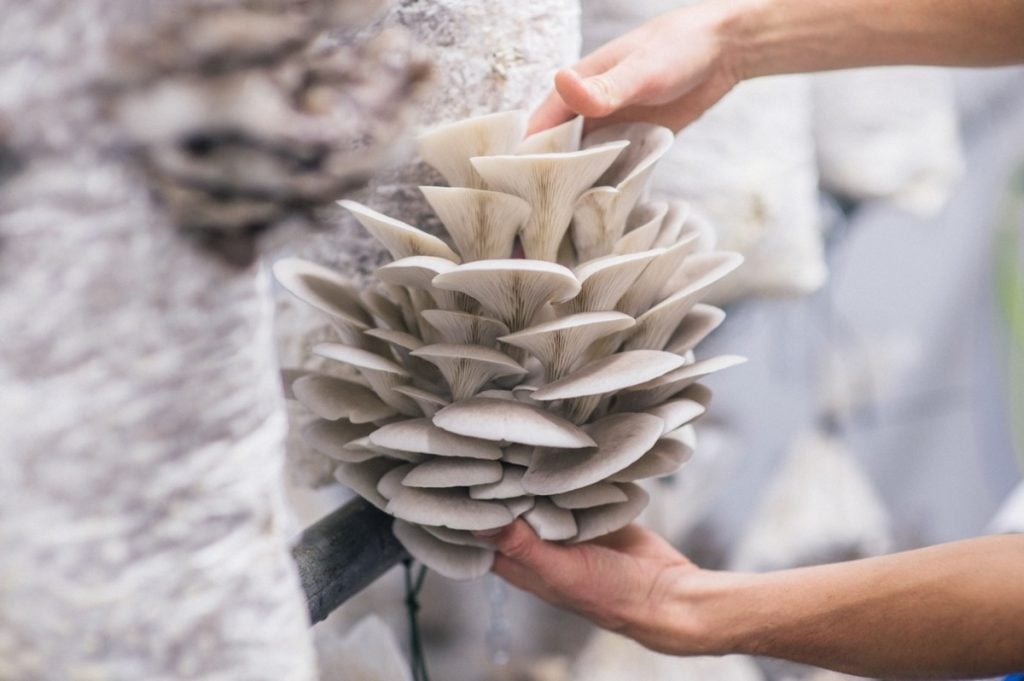
Why is Humidity Important for Mushroom Cultivation?
Humidity is important for mushroom cultivation as around 90% of the mushroom fruiting body consists of water, and they need high humidity levels to develop correctly.
Mushrooms do not have thick skin to protect them from the environment and will lose water and weight quickly if humidity levels drop below 85%.
In the wild, mushrooms can remain dormant for years until the correct temperatures and humidity levels are present.
High humidity levels help to trigger mushroom pinning and are extremely important in the early stages of mushroom growth. Low humidity levels at this stage may result in the mushroom pins drying out and failing to grow.
Although mushrooms can get by with a little less humidity after the pinning stage, correct humidity levels are important throughout the growing process.
Maintaining ideal humidity while growing mushrooms results in larger yields and longer-lasting mushrooms after harvest as they’re healthy and well-hydrated.
And correct humidity levels are not only critical during the fruiting stage. Your mushroom substrate also needs specific moisture content for the mushroom mycelium to thrive.
What Humidity Levels do Mushrooms Need to Grow?
Humidity requirements vary depending on the type of mushroom, but generally, most species thrive with relative humidity levels of 85 to 95%.
Humidity levels that are too low may cause the mushrooms to dry out and stop growing, but if your humidity levels are too high, it encourages the growth of mushroom contaminants like mold and bacteria.
What humidity is good for mycelium growth?
Ideal moisture levels for mycelium growth vary from species to species, but most thrive in substrates with a 60% to 75% moisture content.
It’s essential to get the moisture content in a substrate correct. If a substrate is too dry, the mycelium will not be able to access the nutrients in the substrate, stunting its growth.
And if the substrate is too wet, it prevents the mycelium from breathing, hindering its growth. Excess moisture also encourages the growth of contaminants.
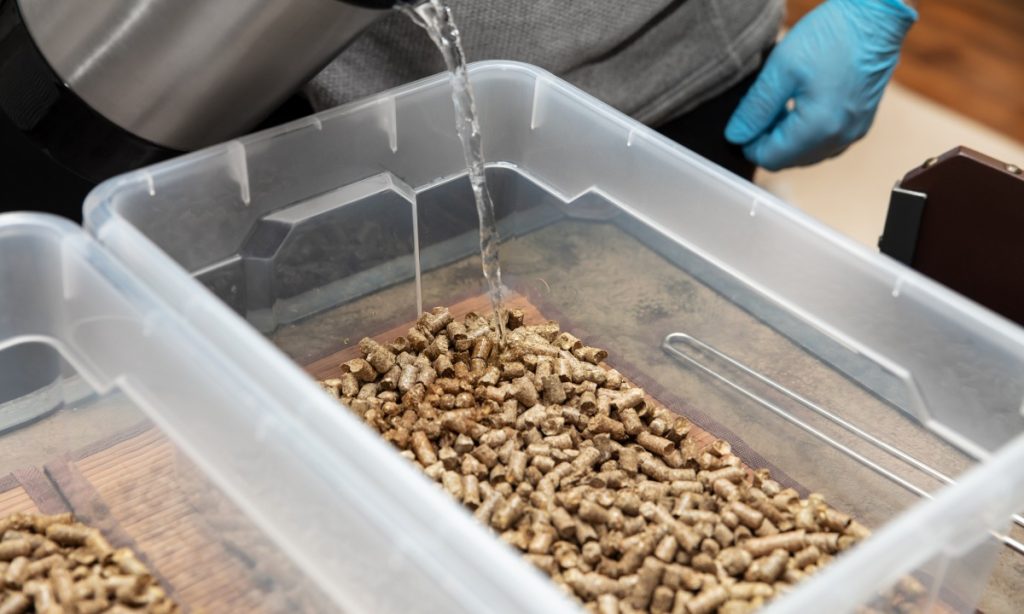
Different Ways to Control Humidity When Growing Mushrooms
There are several ways for mushroom cultivators to control humidity, and which is best for you depends on the size of your mushroom operation and the mushroom species you’re growing.
Here are 5 ways to control humidity levels when growing mushrooms:
1. Spray Bottle
If you’re only growing a few mushrooms, a spray bottle is an inexpensive and effective way to maintain humidity levels as long as you remember to mist your mushrooms several times a day.
The fine mist from the spray bottle creates tiny droplets that stick to surfaces and increase humidity levels as they evaporate.
Spray bottles work best in areas with higher levels of natural humidity, like kitchens, bathrooms or greenhouses, and are ideal for use with monotubs and shotgun fruiting chambers.
If possible, try to spray around the mushrooms and avoid directly spraying the substrate and mushrooms, as excess water droplets on mushrooms can cause contamination.
How often you need to mist your mushrooms will depend on the location and natural humidity levels, but generally, you would need to mist them at least twice a day.
Spray bottles are ideal for small-scale mushroom growing but not the best solution for large operations as they require manual labor and are not guaranteed to provide consistent humidity levels.
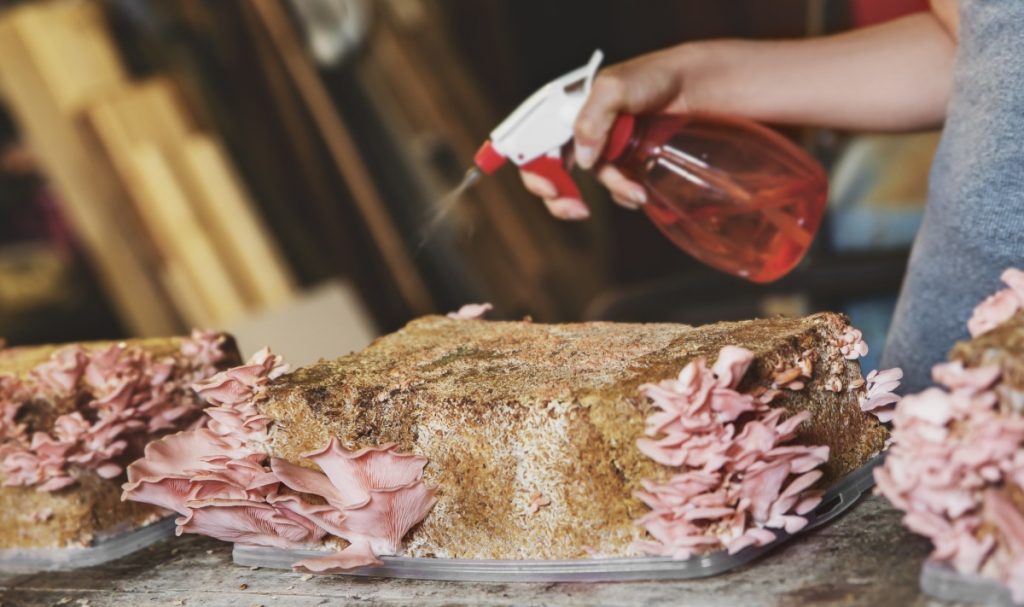
2. Perlite
A layer of moist perlite in the bottom of a small fruiting chamber is another way for small-scale mushroom cultivators to maintain high humidity levels during fruiting.
Perlite is a lightweight material made from volcanic rock, found at most garden stores, that has lots of tiny nooks and crannies to capture and hold water.
Perlite is commonly used in shotgun fruiting chambers with holes below the layer of perlite to allow air to enter the chamber.
The fresh air that enters through these holes rises through the moist perlite, causing the water trapped in the perlite to evaporate, increasing humidity levels in the fruiting chamber.
Perlite only works in enclosed spaces and is only suitable for small fruiting chambers.

3. Humidifier
Humidifiers come in many shapes and sizes, ranging from small home-scale humidifiers to large industrial-size humidifiers ideal for commercial mushroom farms.
Some of the smaller humidifiers, designed for home use, may not be suitable for mushroom growing as they cannot create 95% relative humidity levels.
In the section below, we’ll look at some of the best humidifiers for mushroom cultivation.
4. Pond Mister
Pond misters require a little preparation to set up for mushroom growing but can consistently provide high humidity levels, making them popular with commercial mushroom growers.
Pond misters sit in water and spray a fine mist into the air, increasing humidity levels quickly.
You can use a pond mister to make an efficient DIY humidifier for mushroom cultivation.
This involves placing an ultrasonic mist maker, like House of Hydro’s high-quality disc fogger units, inside a sealed container with an auto-fill float and a waterproof fan.
The video below from Oak and Spore Mushroom Farm shows you how to build a DIY mushroom-growing humidifier using a pond mister.
5. High-Pressure Mist Nozzles
High-pressure mist nozzles are a more complex solution to creating the correct humidity levels and are used more in commercial farms and mushroom greenhouses.
This method requires a high-pressure air system to supply high-pressure water to a series of mist nozzles on the ceiling or at the top of the sidewalls of a growing room.
These nozzles produce a fine mist that evaporates before it reaches the surface of the mushrooms, ensuring they don’t get brown spots.
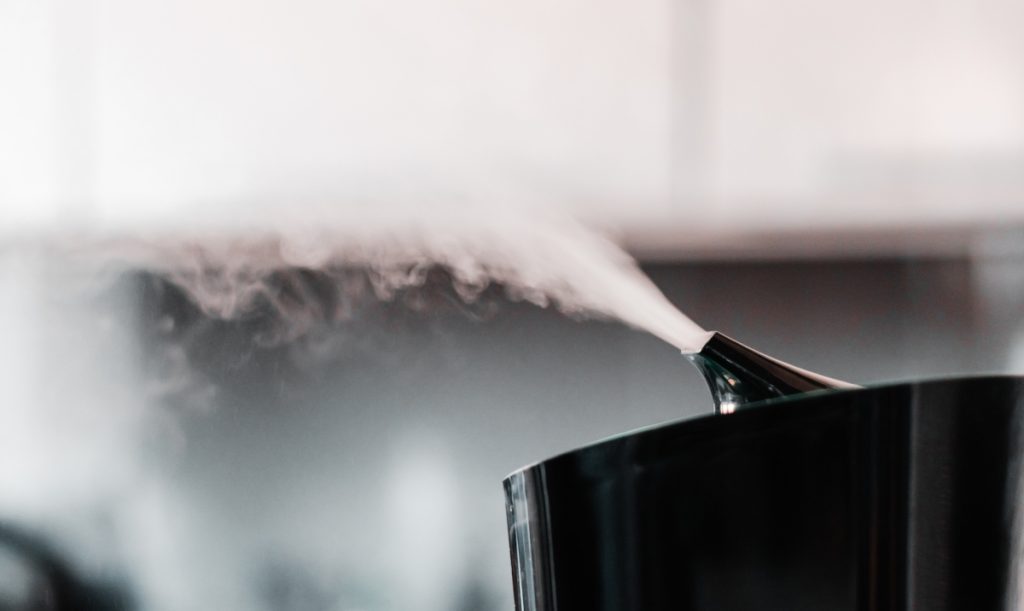
Different Types of Humidifiers for Mushroom Growing
You can use several types of humidifiers for mushroom growing, but ideally, you want one that can increase relative humidity to at least 95%.
Here are some of the options available:
Evaporative/Wicking Humidifiers
Wicking or evaporative humidifiers are an option for small fruiting chambers in dry climates where a spray bottle alone won’t do the trick.
These humidifiers use a wick or wicking filter to draw water up from the humidifier’s tank. A fan then blows air through the wick, evaporating some of the water and increasing relative humidity.
This humid air is then blown into the fruiting chamber through a PVC pipe attached to the outlet of the humidifier.
Evaporative humidifiers are best used in smaller fruiting chambers and with mushroom species that can tolerate lower humidity levels as they’re self-regulating and often won’t increase relative humidity to more than 85%.
They’re self-regulating because the higher the humidity in the surrounding air, the harder it is for the water to evaporate off the wick, decreasing the amount of water vapor generated.
Ultrasonic Humidifiers
If you’ve tried your hand at mushroom growing successfully and want to expand your operation, an ultrasonic humidifier is the way to go.
Ultrasonic humidifiers use spinning discs to create high-frequency vibrations that vaporize water droplets, forming a fine mist.
They’re a favorite with mushroom cultivators as they can consistently provide relative humidity levels of 95% and above and are relatively easy to set up and maintain.

How to Manage Humidity Levels in a Fruiting Chamber
Ultrasonic mushroom humidifiers are the easiest way to maintain high relative humidity in fruiting chambers of all sizes, from a Martha grow tent to a walk-in mushroom grow room.
If you are new to mushroom growing, you may wonder, “How do you use a mushroom humidifier?”
It’s best to have a humidity control system of some sort, like an on/off timer or humidistat controller, to ensure the humidity levels stay within a set range for the duration of fruiting.
If you plan on using an on/off timer, you’ll need to monitor the humidity levels for the first few days until you work out the ideal timing pattern to maintain the desired humidity range in your growing space.
A humidistat makes it a little easier as it monitors the humidity in the fruiting chamber for you. When levels drop below the set point, the humidistat triggers the humidifier unit to start, increasing humidity.
Once the desired level is reached, the humidifier will switch off.
In addition to a humidifier unit, you can maintain a small layer of water on the floor of a grow room to help buffer any swings in humidity.
Remember, humidifiers for mushroom growing need to be cleaned regularly to prevent contaminants from breeding inside the humidifier unit and entering the fruiting chamber with the mist.
Final Thoughts
Depending on your climate and the amount of mushrooms you’re growing, ensuring high humidity may be as simple as misting your mushrooms a couple of times a day.
But larger mushroom farms and those wanting to grow mushrooms year-round usually need something less labor-intensive and more consistent.
A humidifier is an excellent option for these cultivators.
When used with an automated humidity control system, they ensure growers can consistently maintain the desired relative humidity range in a fruiting chamber.
For more mushroom-growing tips and resources, visit our Mushroom Growing Hub or download our free video and e-book on how to set up a low-tech mushroom farm.
